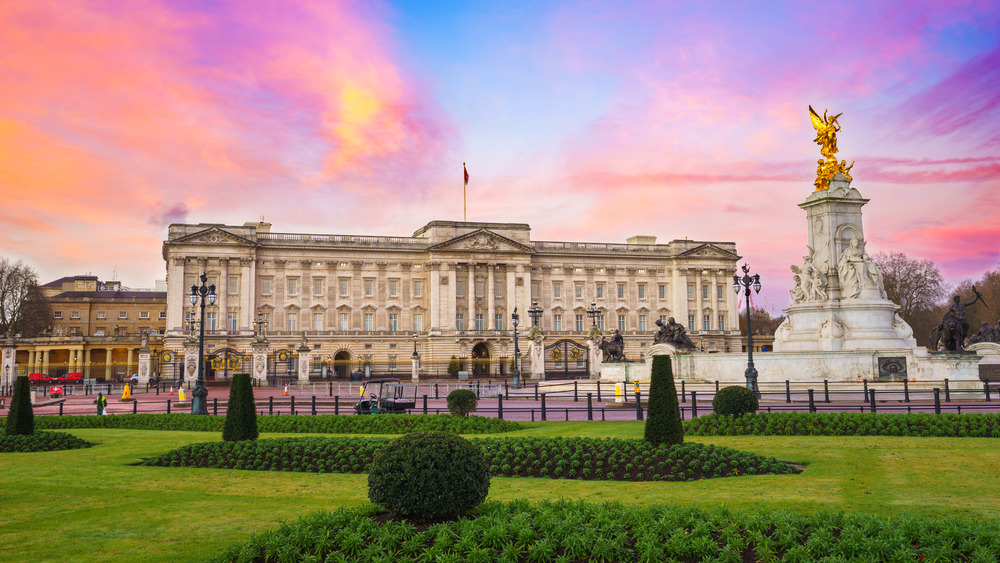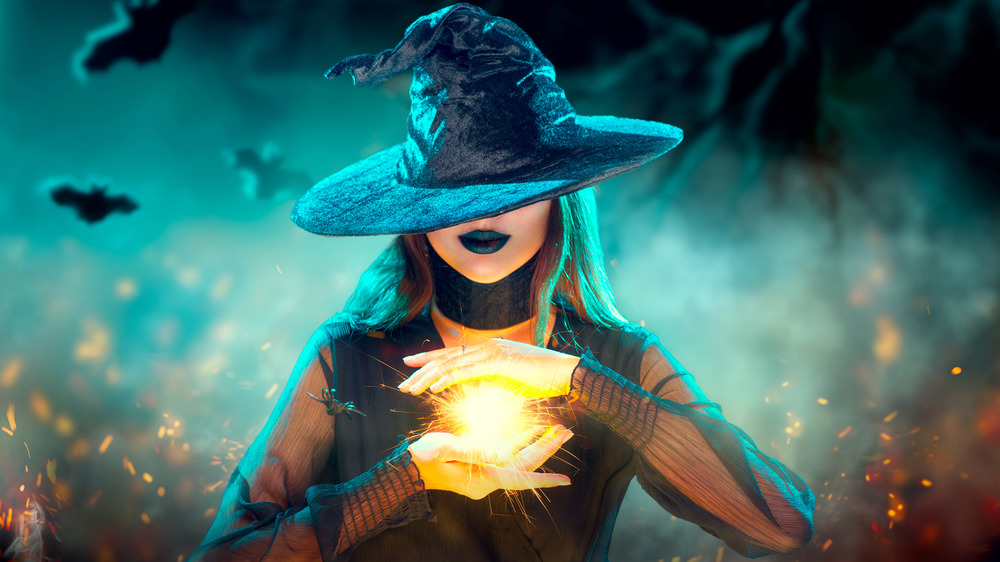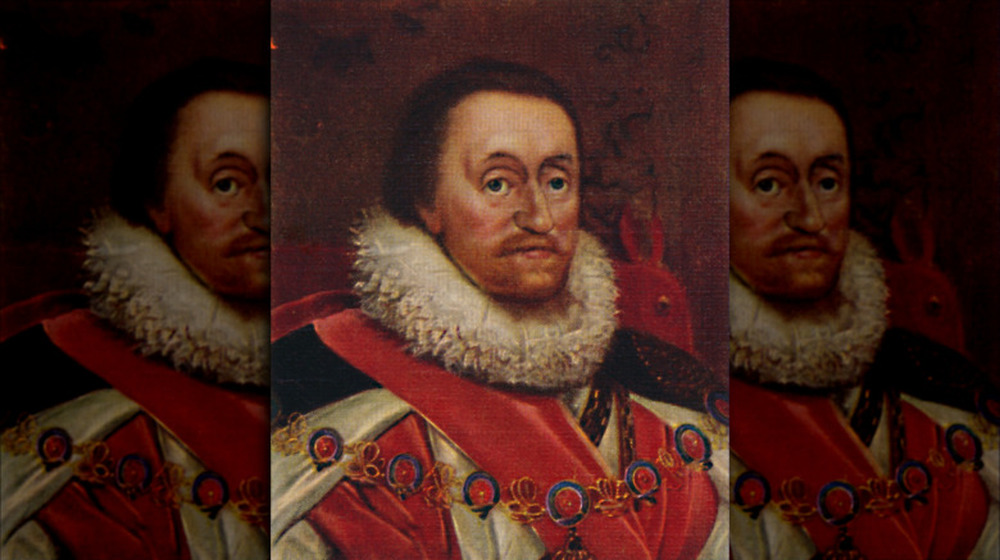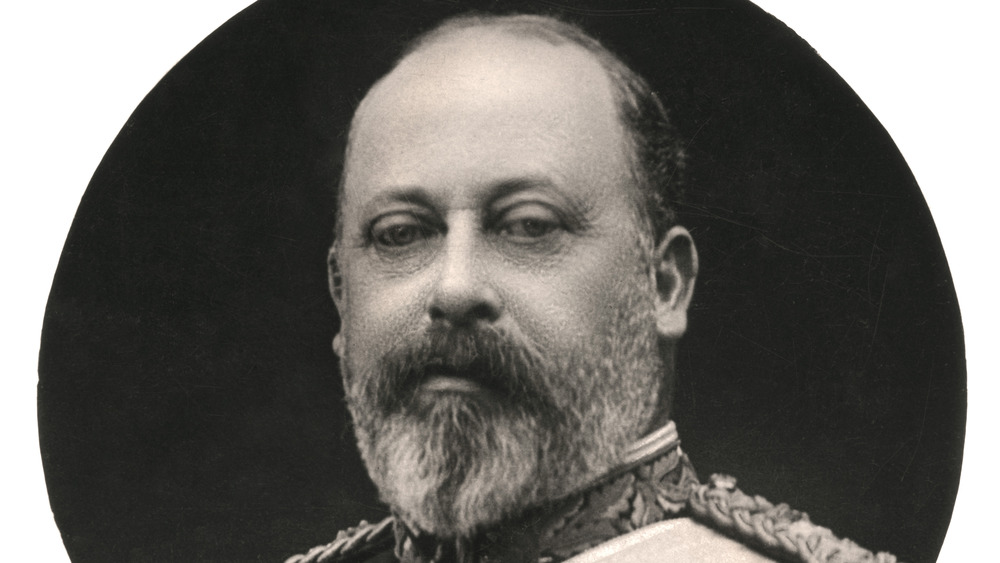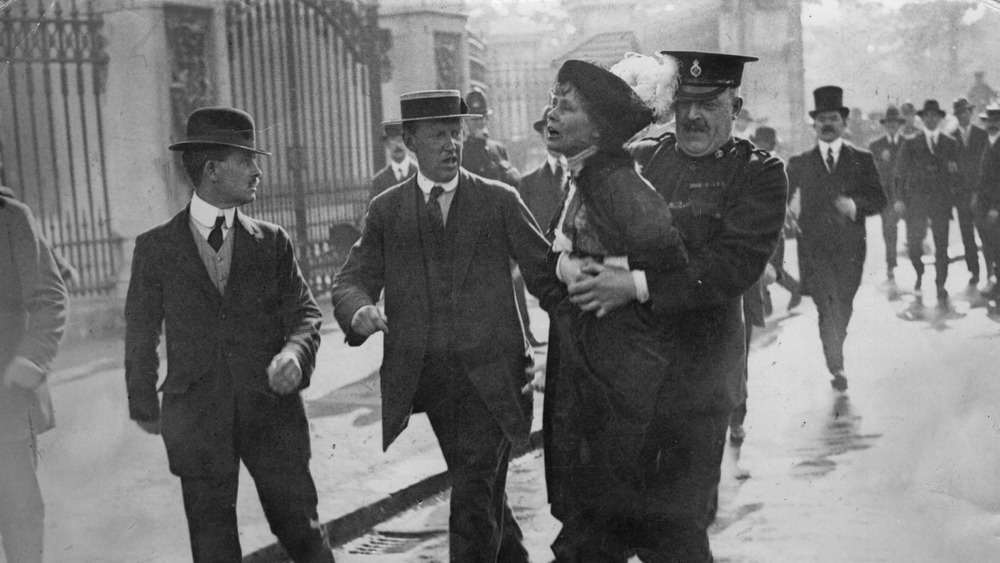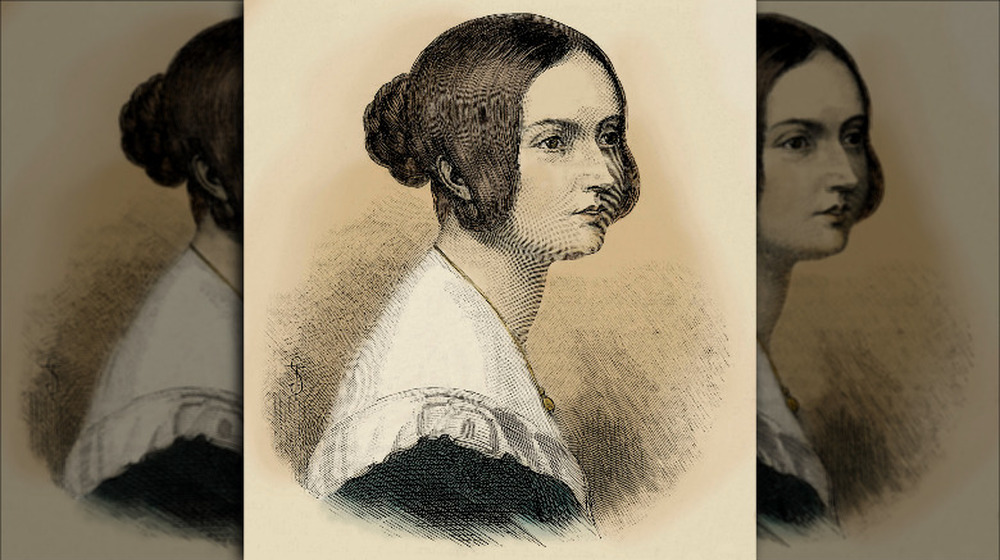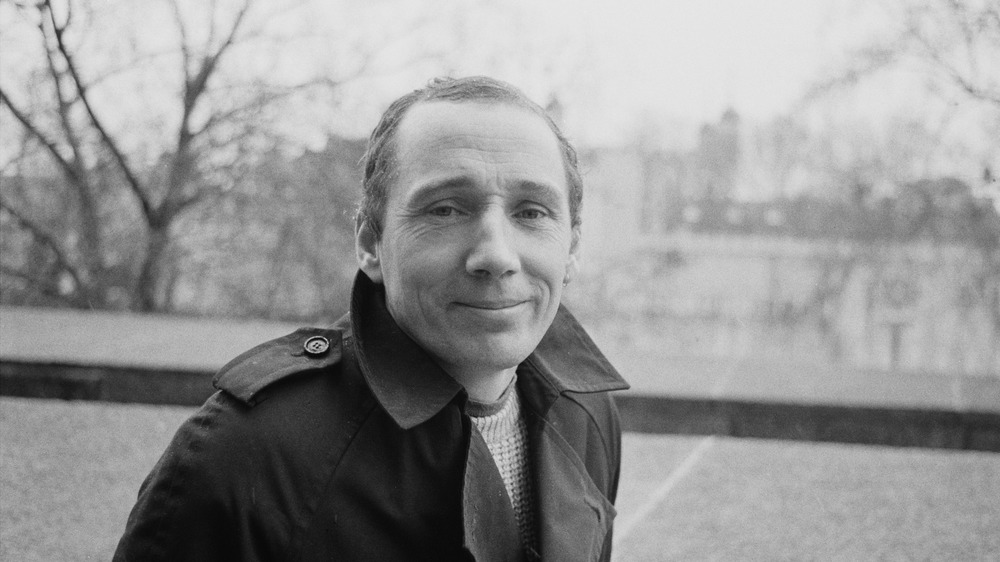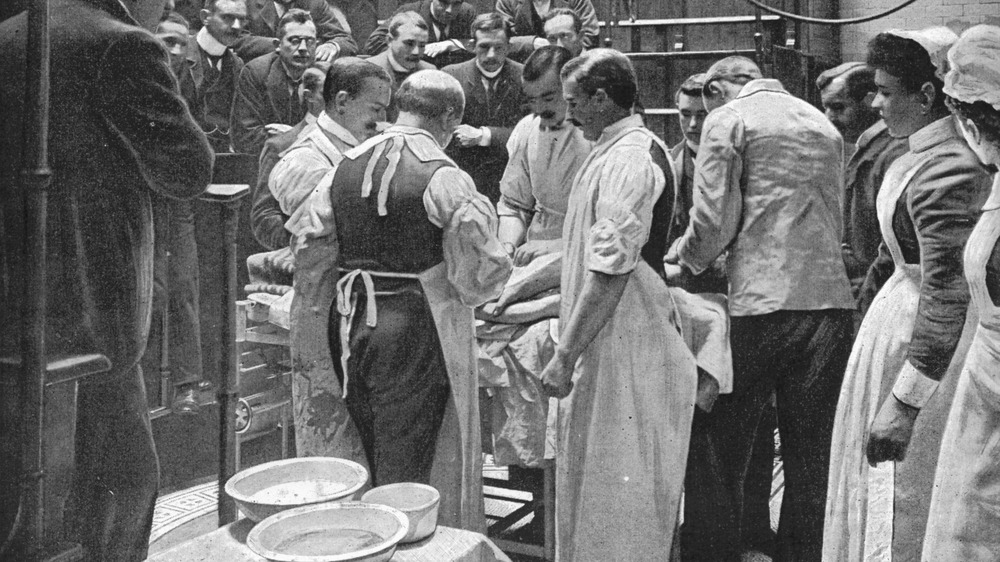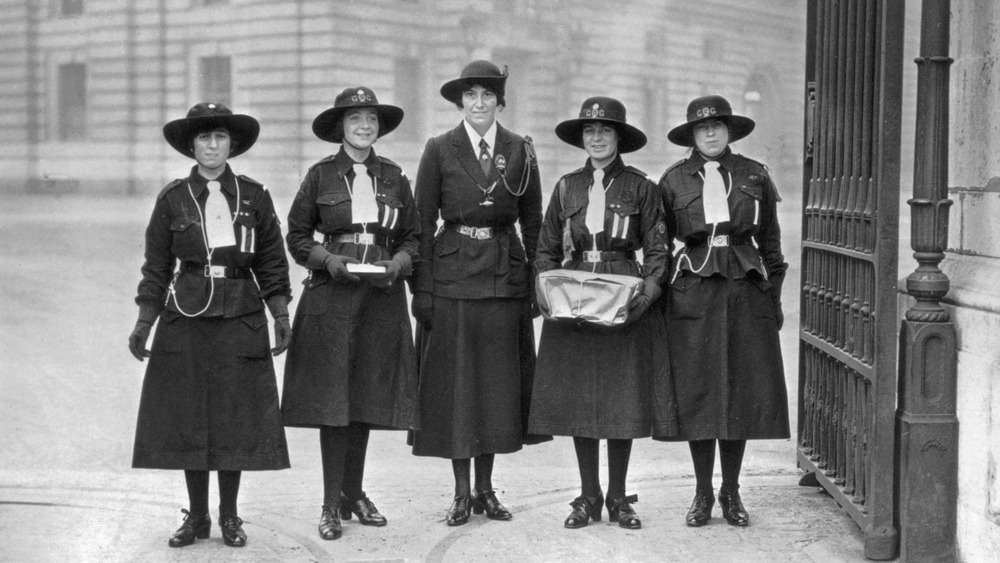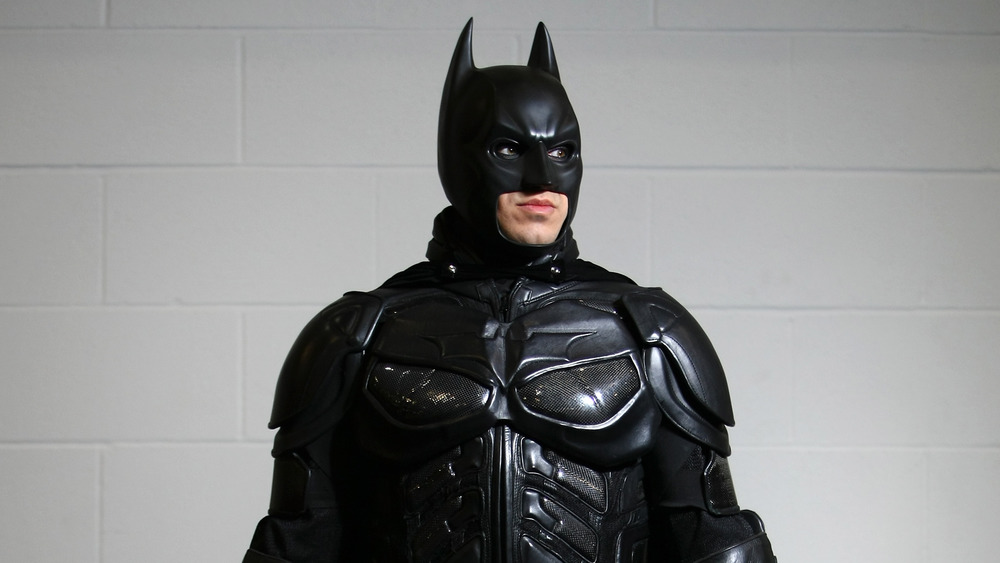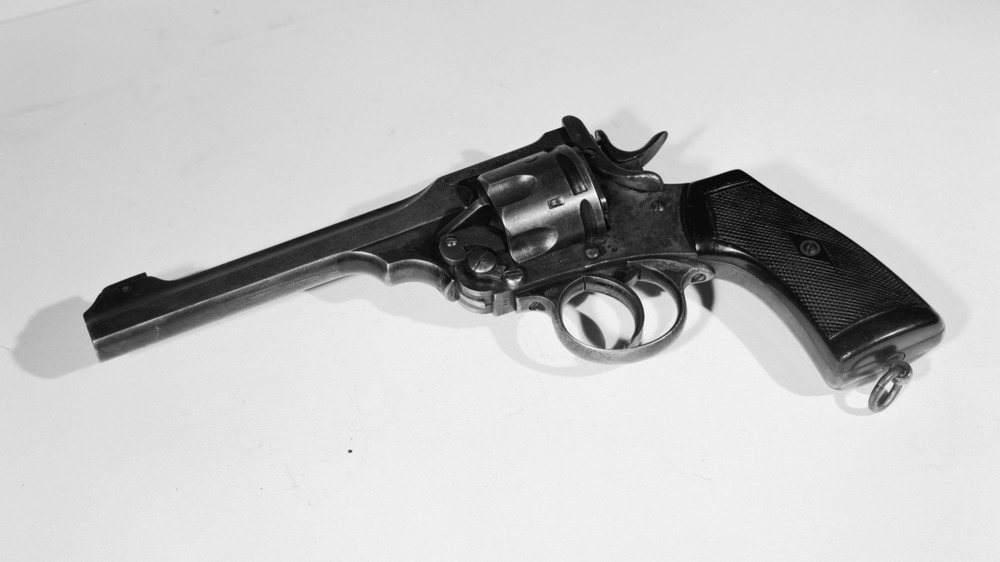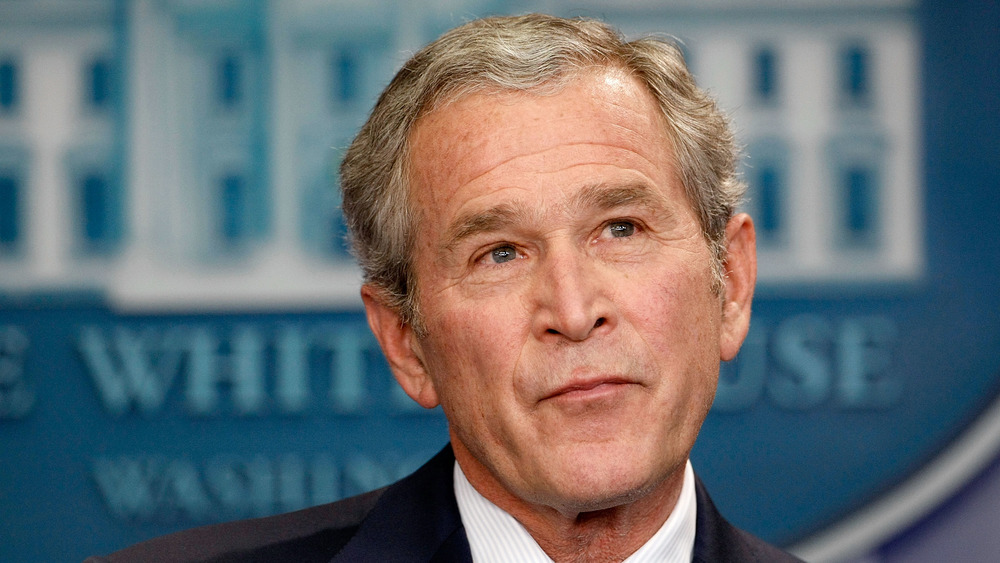The Most Bizarre Things To Ever Happen At Buckingham Palace
The house where the Queen of England dozes off in front of the television has a history going back several hundred years. Originally a marshy spot just outside London, the Duke of Buckingham built the original structure back in 1703, calling it Buckingham House. His illegitimate son sold it to King George III (the guy we Americans rebelled against) in 1761. It remained a private home for members of the royal family until Queen Victoria made it her official residence in 1837.
Being the official residence of English monarchs for nearly 200 years means a lot of weird history has unfolded at the palace. Kings and queens are just people born into extraordinarily lucky families, after all, and their decision-making wasn't always the best. And, in the end even, a palace is just a very, very large house — sometimes people get in who aren't supposed to be there. As a symbol of the monarchy's authority and power, the palace also attracts a fair number of kooks, activists, and protesters, often with unexpected results.
You might think of Queen Elizabeth's typically dour and unamused expression and think that life at Buckingham Palace is probably pretty stiff and dull — certainly Netflix's The Crown makes it look that way — but there's a lot of weird history there. In fact, here's a list of the most bizarre things to ever happen at the royal palace.
A witch once lived at Buckingham Palace
Before there was a palace — or, in fact, any house at all — an alleged witch lived on the grounds. Back then, the spot where Buckingham Palace now stands was a soggy marsh fed by the river Tyburn, which actually still flows under the palace. Where the river was shallow enough to cross, a small village called Eye Cross sprang up. According to the Sunday Express, a woman named Margarie Gourdemaine was born there in the late 1300s — and became known as the Witch of Eye.
As historian Patricia Wright explains, by the 1420s, Eye was nearly abandoned. The half-empty village was the ideal environment for a witch, and it seems likely that Gourdemaine lived her entire life in the ruins of the small community. When Gourdemaine began practicing "witchcraft," it was probably not controversial — witches at the time acted as midwives, herbalists, and physicians for people at a time when medicine and science were primitive at best.
But in the early 1420s, the church launched a campaign against heresy, and Gourdemaine was swept up in a political struggle where accusations of using witchcraft were thrown around pretty casually. She was burned at the stake — probably on the grounds that the palace now stands on — in 1441.
King James I tried to raise silkworms at Buckingham Palace
If you read history books about the English monarchy, a surprising theme emerges: poverty. English kings and queens are forever begging for money — from their subjects, from foreign powers, and even from their own family. England itself became prosperous over the years as it garnered a huge worldwide empire. But the kings of old weren't immune to get-rich quick schemes, and King James I though he'd hit upon a genius idea in 1609.
As the Los Angeles Times reports, James I ordered the planting of 100,000 mulberry trees all over the country to try to break into the profitable silk industry. And historian Patricia Wright notes that James had a large mulberry orchard planted right on the land where Buckingham Palace sits today. Silk was one of the most traded materials in the world at the time — very expensive and difficult to acquire. If James had been able to cultivate silkworms in England, history itself might have been changed.
Unfortunately, King James used the wrong kind of mulberry tree. He planted black mulberries, which is a species of the plant that silkworms don't like to eat. The whole scheme ended in failure, without a single strand of silk being produced for the king or for England.
A king was born — and died — in Buckingham Palace
It might be hard for the modern generation to believe, but back in the mid-1800s, it was very common for women to give birth to their children in their home. And the phrase "very common" should be understood to mean "just about always." First of all, the modern hospital as we understand it didn't exist. And as professor Maiken Scott explains, up until the mid-1700s, the practice of calling a midwife instead of a doctor wasn't even questioned — it was just how things were done.
So it's not entirely surprising that King Edward VII was born at Buckingham Palace. His mother, Queen Victoria, made the house the official royal resident a few years before, in 1837. As historian Jane Ridley notes, Queen Victoria didn't want a child and was extremely distraught at being pregnant. The chances of something going wrong with the birth of the heir to the English throne was considered so dangerous the doctor in attendance had to be paid a bonus as compensation for the risk.
What is kind of unusual is that nearly 70 years later, Edward VII died in the palace as well. He is, in fact, the only English monarch to be born and die at Buckingham Palace. For eight days, Edward VII was left on the bed where he died, in fact, and visitors were able to pay their respects in person.
Suffragettes got a little too attached
Buckingham Palace is a natural spot for protesters. It's fun to imagine the queen peeking out through the blinds in shock as you speak truth to power. In the early 1900s, the palace attracted the attentions of the surprisingly violent women's suffrage movement.
Prior to 1918, women weren't legally able to vote in the United Kingdom, which irked a lot of them. As reported by the British Library, after attempts to pass compromise laws failed, the Suffragette movement in the U.K. became increasingly violent. Windows were smashed, fires were set, and mobs of women would descend on public area to cause disorder. As the National Portrait Gallery notes, on May 21, 1914, one of the movement's key leaders, Emmeline Pankhurst — who had recently survived being force-fed while attempting a hunger strike — led about 200 women to Buckingham Palace in order to confront the king about the vote.
As writer June Purvis notes, the women were armed with fake weapons and eggshells filled with paint — and were met by 2,000 police officers who had been ordered to stop them. The scene became a riot. Young men assaulted the women, and the police weren't gentle. Pankhurst managed to get to the gates (reportedly at least two other Suffragettes chained themselves to the gates) before she was carried off, kicking and screaming, by the police. She had the last laugh — the women got the vote, and Pankhurst was elected to the House of Commons in 1927.
A teenager stole Queen Victoria's underwear
In the 19th century, Buckingham Palace had pretty much zero security. According to author Jan Bondeson, many of the ground-level doors and windows were routinely left unlocked, and there was very little by way of organized patrol.
A teenager named Edward Jones took advantage of that fact. As BBC News reports, Jones had an apparent obsession with young Queen Victoria. While no one has recorded the reason for his obsession, history has recorded the result: In 1838 he was caught after sneaking into Buckingham Palace and stealing several items belonging to the queen — including several articles of her underwear.
Remarkably, despite being caught, Jones returned two more times — and told people he'd actually entered the palace many more times when he hadn't been caught. Jones was eventually charged and tried, but trespassing and underwear theft wasn't a major crime, so his sentence was just three months. When he continued to be a nuisance, he was essentially kidnapped and put on a ship bound for Brazil. When he doggedly returned, they put him on a prison ship — and held him there for six years. Then he was finally deported to Australia — and still came back.
Eventually, the older, alcoholic Jones went back to Australia and remained there for the rest of his life, apparently embarrassed about his status as Queen Victoria's stalker.
A trespasser had a conversation with Queen Elizabeth in 1982
Believe it or not, until the passage of the Serious Organized Crime and Police Act of 2005, it wasn't actually illegal to trespass in Buckingham Palace. As long as you left when asked and didn't commit any crimes where there, you would face no criminal charges.
According to The Washington Post, a man named Michael Fagan took advantage of this fact in 1982. Fagan, an unemployed laborer, climbed up a drain pipe and found that the armed guard posted outside Queen Elizabeth II's bedroom had left his post (apparently to have a cigarette). Naturally, he went into the private apartment where the Queen was sleeping.
The queen kept her head and didn't panic. She spoke with Fagan for a few minutes. According to Cosmopolitan, the conversation wasn't anything special — just a few startled words.
When Fagan asked her for a cigarette of his own, she used the excuse to phone for help. Fagan was escorted from the premises, and later said he did it because he was frustrated with the direction of his life. Incredibly, since he hadn't actually committed a crime, he wasn't charged with anything — the queen could have made a civil complaint but chose to avoid the publicity. This event led directly to the new law criminalizing these intrusions.
They performed surgery on King Edward VII at Buckingham Palace
Edward VII, son of Queen Victoria and Prince Albert, was born in Buckingham Palace in 1841 and died there 69 years later in 1910. The palace was inextricably linked to a man who might qualify as England's most-overlooked monarch. And there was one more major event that tied the king to his palace.
Edward VII had spent 60 years as the heir apparent and Prince of Wales, so when his mother died in January 1901, he was determined to ascend to the throne. His coronation was scheduled for June of 1902, but he began to feel ill and was diagnosed with appendicitis just a few days before the event. As historian Christopher Hibbert notes, Edward VII refused to admit how ill he was and refused any sort of treatment.
Then his illness led to peritonitis, a dangerous infection. At the time, operations for appendicitis were rare — and the condition was typically fatal. But recent developments in anesthesia and surgery made it just possible to treat the new king. As Good Housekeeping reports, a room was converted into an operating theater. The king walked from his bedroom, was knocked out, and a successful drainage operation was performed. The operation is routine today, but in 1902 was considered quite radical, which means medical history was made not only on a king but in a royal palace.
Buckingham Palace hosted Girl Guides
The Boy Scouts were formed in England in the early 20th century. And as Southern Living reports, a few years later a group of girls demanded a similar organization, resulting in the Girl Guides (very much like America's Girl Scouts).
The queen at the time, Elizabeth Bowes-Lyon (the mother of Queen Elizabeth II) was a big fan — her sister Mary actually served as president of the Girl Guides. So it's not too surprising that Good Housekeeping reports that the future queen and her sister Margaret joined the Girl Guides in 1937. It's a little surprising that they chose to form their own company, made up entirely of princesses and the daughters of palace employees.
The 1st Buckingham Palace Company of Girl Guides used a building in the palace gardens as their headquarters but was disbanded in 1939 due to World War II. They later reformed at Windsor Castle in 1942. Queen Elizabeth II re-formed it in 1959 for her own daughter, Anne, and but the group was disbanded again in 1965.
Whether or not the company will be resurrected for the new generation of princesses remains to be seen — but it's worth noting that The Telegraph reports the Duchess of Cambridge, Kate Middleton, was a Brownie as a child and took up a position as a scout leader in 2012.
A naked paraglider once landed outside of Buckingham Palace
The relaxed attitude towards security practiced at Buckingham Palace is truly shocking. There have been multiple break-ins and cases of trespassing, after all. But the most insane example of unwanted visitors happened in 2000, when a naked man used a paraglider to land just outside the royal palace. Thanks to a helicopter pilot who spotted him, the police were well aware of his intentions, so they were waiting for him when he landed, where they quickly arrested him.
According to The Guardian, he was an Australian named Brett De La Mare. He was a frustrated author who really leaned into the idea that there's no such thing as bad publicity. His plan was simple: He would pull a crazy stunt and then wait for the lucrative book deals to roll in. According to BBC News, De La Mare described himself as "desperate." He'd been living off his savings and was nearly broke. He believed publishing a book to just the Australian market wouldn't be lucrative enough, so he wanted to make himself world-famous and expand his platform. Regardless of his stunt, he's not exactly a household name.
Batman once climbed Buckingham Palace
There are many things you automatically associate with Buckingham Palace. The queen, of course. The changing of the guard. Tourists. And, naturally, Batman.
At least that was the case for a brief moment in time in 2004. As The New York Times reports, a group of father's rights advocates called Fathers 4 Justice arrived to stage a protest. The group already had a reputation for attention-grabbing (but non-violent) stunts, like pelting the prime minister with condoms filled with purple flour, so it wasn't entirely surprising when one of the men, Jason Hatch, showed up dressed as Batman.
What was surprising was when Hatch really got into character and scaled the gates, ran to a ladder, and climbed up to a ledge just outside the queen's balcony. He unfurled a banner that read, "Super Dads of Fathers 4 Justice, Fighting for Your Right to See Your Kids," and then refused to come down. For five hours. He apparently had a pretty good time — he waved at tourists and carried on a good-natured conversation with the police. When he finally agreed to come down, he took off his mask, and the cops used a crane to lower him to the ground while his supporters chanted, "Free Batman!"
Scandal led to a tragedy at Buckingham Palace
There's been surprisingly little actual scandal or violence at Buckingham Palace. Considering it's home to a family that's been among the most powerful and richest in the world for generations, that's kind of a remarkable achievement.
But the palace isn't completely free of tragedy. The Sunday Guardian Live reports that a man named Maj. John Gwynne served as private secretary to King Edward VII. Gwynne had an unhappy marriage, and eventually it ended in divorce. This being the early 20th century, however, divorce wasn't widely accepted — and the royal family frowned on it harder than anyone. Thirty years later, King Edward VIII was forced to abdicate, because he insisted on marrying a divorced woman, after all.
Gwynne found himself the subject of vicious rumor and was followed by scandal wherever he went. The pressure got to him, and he eventually walked into one of the first-floor offices in the palace and shot himself in the head. Those offices are still used to this day, and according to author Gilly Pickup, it's common for people to claim they' are haunted by Gwynne's ghost.
If you or anyone you know is having suicidal thoughts, please call the National Suicide Prevention Lifeline at 1-800-273-TALK (8255).
A reporter once took photos of President Bush's bed
When it comes to security breaches at Buckingham Palace, they're usually committed by men obsessed with the reigning queen or people seeking publicity. But in 2003 there was an interloper whose goal was much more mercenary: He wanted to expose what life was really like inside the Palace — and he brought a camera to do so.
As The New York Times reports, The Daily Mirror assigned one of its reporters, Ryan Parry, to infiltrate the palace for a story ostensibly about security there. Parry did what can only be called an amazing job. He used a fake resume — but his real name — to get a job as a lowly footman in the palace. He then spent several days wandering about taking photos and observing the royals in their natural environment.
And he did all this in the midst of a state visit from President George W. Bush. Parry even took photos of the bed that Bush slept in for some reason.
The story was a big deal, of course. Not only were some of the details Parry revealed kind of shockingly weird (the queen eats corn flakes out of Tupperware every morning, apparently), but the security breach during the president's visit was a major embarrassment.
